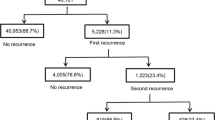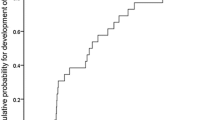Abstract
Background
Cholecystectomy usually is recommended for patients with gallbladder (GB) stones who previously underwent endoscopic removal of common bile duct (CBD) stones. However, in practice, many patients still have GB stones after improvement of their biliary symptoms. This study aimed to evaluate risk factors for cholecystectomy in patients with GB stones after complete endoscopic clearance of CBD stones.
Methods
From August 2003 to April 2006, the medical data of 61 patients with concomitant GB stones who underwent complete endoscopic clearance of CBD stones were reviewed retrospectively. The risk factors for subsequent cholecystectomy were evaluated during a 24-month of follow-up period.
Results
Among the 61 patients, 12 (19.7%) subsequently required cholecystectomy for recurrence of biliary symptoms, and 11 of these 12 patients (91.7%) needed cholecystectomy within 12 months. Gallbladder stones 10 mm or larger (p = 0.037) and the acute pancreatitis (p = 0.049) were the independent risk factors for subsequent cholecystectomy. The actuarial probability of remaining free of subsequent cholecystectomy during the follow-up period was higher for the patients with GB stones smaller than 10 mm than for the patients with GB stones 10 mm or larger (86.7% vs. 62.5%; p = 0.037). In addition, the patients with acute pancreatitis had a higher tendency for subsequent cholecystectomy than the patients without acute pancreatitis (50% vs. 16.4%; p = 0.078).
Conclusions
Only a small number of patients subsequently needed to undergo cholecystectomy for recurrence of biliary symptoms, and most events developed within 12 months. For the patients with GB stones 10 mm or larger or acute pancreatitis, prophylactic cholecystectomy is strongly recommended after complete clearance of CBD stones.


Similar content being viewed by others
References
Schreurs WH, Juttmann JR, Stuifbergen WNHM, Oostvogel HJ, van Vroonhoven TJ (2002) Management of common bile duct stones: selective endoscopic retrograde cholangiography and endoscopic sphincterotomy: short- and long-term results. Surg Endosc 16:1068–1072
Hill J, Martin DF, Tweedle DE (1991) Risks of leaving the gallbladder in situ after endoscopic sphincterotomy for bile duct stones. Br J Surg 78:554–557
Hammarström LE, Holmin T, Stridbeck H, Ihse I (1995) Long-term follow-up of a prospective randomized study of endoscopic versus surgical treatment of bile duct calculi in patients with gallbladder in situ. Br J Surg 82:1516–1521
Boerma D, Rauws EA, Keulemans YC, Janssen IM, Bolwerk CJ, Timmer R, Boerma EJ, Obertop H, Huibregtse K, Gouma DJ (2002) Wait-and-see policy or laparoscopic cholecystectomy after endoscopic sphincterotomy for bile duct stones: a randomised trial. Lancet 360:761–765
Tanaka M, Ikeda S, Yoshimoto H, Matsumoto S (1987) The long-term fate of the gallbladder after endoscopic sphincterotomy: complete follow-up study of 122 patients. Am J Surg 154:505–509
Lund J (1960) Surgical indications in cholelithiasis: prophylactic choleithiasis: prophylactic cholecystectomy elucidated on the basis of long-term follow up on 526 nonoperated cases. Ann Surg 151:153–162
Keulemans YC, Rauws EA, Huibregtse K, Gouma DJ (1997) Current management of the gallbladder after endoscopic sphincterotomy for common bile duct stones. Gastrointest Endosc 46:514–519
Venneman NG, Buskens E, Besselink MG, Stads S, Go PM, Bosscha K, van Berge-Henegouwen GP, van Erpecum KJ (2005) Small gallstones are associated with increased risk of acute pancreatitis: potential benefits of prophylactic cholecystectomy? Am J Gastroenterol 100:2540–2550
Lee JK, Ryu JK, Park JK, Yoon WJ, Lee SH, Lee KH, Kim YT, Yoon YB (2006) Risk factors of acute cholecystitis after endoscopic common bile duct stone removal. World J Gastroenterol 12:956–960
Kwon SK, Lee BS, Kim NJ, Lee HY, Chae HB, Youn SJ, Park SM (2001) Is cholecystectomy necessary after ERCP for bile duct stones in patients with gallbladder in situ? Korean J Intern Med 16:254–259
Hammarstrom LE, Holmin T, Stridbeck H (1996) Endoscopic treatment of bile duct calculi in patients with gallbladder in situ: long-term outcome and factors. Scand J Gastroenterol 31:294–301
Keizman D, Ish Shalom M, Konikoff FM (2006) Recurrent symptomatic common bile duct stones after endoscopic stone extraction in elderly patients. Gastrointest Endosc 64:60–65
Harris HW, Davis BR, Vitale GC (2005) Cholecystectomy after endoscopic sphincterotomy for common bile duct stones: is surgery necessary? Surg Innov 12:187–194
Schreurs WH, Vles WJ, Stuifbergen WH, Oostvogel HJ (2004) Endoscopic management of common bile duct stones leaving the gallbladder in situ: a cohort study with long-term follow-up. Dig Surg 21:60–64
Macadam RC, Goodall RJ (2004) Long-term symptoms following endoscopic sphincterotomy for common bile duct stones. Surg Endosc 18:363–366
Kullman E, Borch K, Dahlin LG, Liedberg G (1991) Long-term follow-up of patients with gallbladder in situ after endoscopic sphincterotomy for choledocholithiasis. Eur J Surg 157:131–135
Hoem D, Viste A, Horn A, Gislason H, Søndenaa K (2006) Cholecystectomy improves long-term success after endoscopic treatment of CBD stones. Hepatogastroenterology 53:655–659
Bhasin DK, Malhi NS (2002) Recurrence of biliary symptoms after endoscopic sphincterectomy for choledocholithiasis in patients with gallbladder stones. Gastrointest Endosc 55:451–453
Sugiyama M, Atomi Y (2002) Risk factors predictive of late complications after endoscopic sphincterotomy for bile duct stones: long-term (more than 10 years) follow-up study. Am J Gastroenterol 97:2763–2767
Saito M, Tsuyuguchi T, Yamaguchi T, Ishihara T, Saisho H (2000) Long-term outcome of endoscopic papillotomy for choledocholithiasis with cholecystolithiasis. Gastrointest Endosc 51:540–545
Jacobsen O, Matzen P (1987) Long-term follow-up study of patients after endoscopic sphincterotomy for choledocholithiasis. Scand J Gastroenterol 22:903–906
Author information
Authors and Affiliations
Corresponding author
Rights and permissions
About this article
Cite this article
Lee, KM., Paik, C.N., Chung, W.C. et al. Risk factors for cholecystectomy in patients with gallbladder stones after endoscopic clearance of common bile duct stones. Surg Endosc 23, 1713–1719 (2009). https://doi.org/10.1007/s00464-008-0269-2
Received:
Revised:
Accepted:
Published:
Issue Date:
DOI: https://doi.org/10.1007/s00464-008-0269-2




